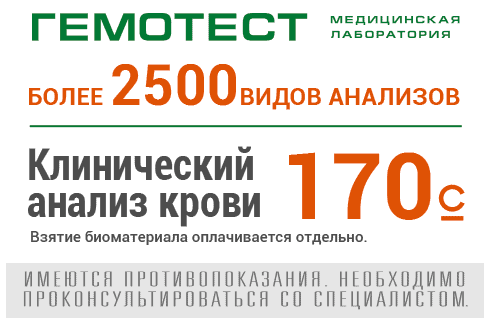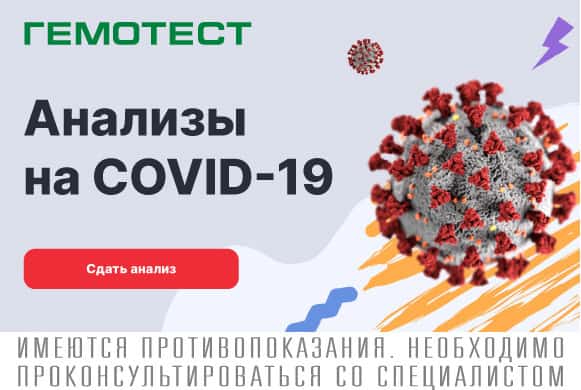Promoting a medical laboratory in Bishkek

- Client: Gemotest – medical laboratory.
- Duration: 01.04.19 until the present moment.
- Primary objective: Market expansion and attracting new clients.
Issues and customer profile
Gemotest is a Russian medical company that utilizes leading global technologies in laboratory diagnostics for patients. The first laboratory was opened in Kyrgyzstan in 2018. In 2019, the company initiated an extensive marketing campaign to expand its network of laboratories across the country. Our main objective was to enter a new market and reach the target audience. This is where our story begins.
The case turned out to be quite extensive, so we have prepared a video where you can get a brief overview of the advertising campaign for Gemotest medical laboratory in Kyrgyzstan. Enjoy watching:
Year 2019. Start of operations
Collaboration with the medical laboratory began in April 2019. At that time, the first media plan (MP) was prepared, which proposed advertising on two platforms – Google Ads and Yandex.Direct. Among the relevant formats, we suggested contextual and banner advertising (CPC, CPM).
For over five months, we discussed the directions for launching the advertising campaign (AC), deliberated on the most suitable design, and tailored the product presentation to the local market. Simultaneously, the website development was underway.
The first launch took place in October. It was decided to start with promotion on Google Ads, focusing on banner advertising format.
- The target audience (TA) was men and women aged 25-60 years old.
- The main targeting was focused on audiences interested in beauty and health.
- The campaign duration was 30 days.
- Geographical targeting included Bishkek and Osh.
In the design of the banners, we utilized a common message that could capture the attention of the target audience by highlighting the competitive pricing and unique features of the laboratory compared to those who have been in the market for a long time.

In November, the work on the website continued, but we decided to prepare the semantic core in advance for the launch of contextual advertising. We identified the main areas of analysis and created separate ad groups for each of them.
The goal of contextual advertising, in addition to attracting customers, was to determine the most relevant services that local residents are interested in.
From November to the end of December 2019, we continued running banner advertising on Google Ads.
Year 2020. Promotional services and work during lockdown conditions
In February, we started running targeted advertising on Facebook Ads for promotional services.
There was a significant interest in the promotions, and we decided to launch similar advertising campaigns on Google Ads and Yandex.Direct. In March, these campaigns were launched as a test with a minimal budget.
We also started testing contextual advertising for general services.
From April to June, we had to temporarily suspend the advertising campaigns due to a city-wide lockdown.
In July, we resumed the advertising campaigns with a timely offer at that moment – the Covid-19 test. Our main objective was to promote this service, while also ensuring the promotion of general services.
We launched the following:
- Contextual and banner advertising on Google Ads.
- Banner advertising on Yandex.Direct.
- Targeted advertising on Facebook Ads.

In August-September, these products remained the most relevant for promotion through the following channels:
- Google Ads.
- Yandex.Direct.
- Facebook Ads.
Based on the previous months and analyzing the metrics, in October we made the following decisions:
- To discontinue the advertising of general banners (due to a high bounce rate) in favor of Covid-19 in contextual advertising networks (RSYA).
- To pause advertising on Facebook and shift the primary focus to Instagram.
- To keep the ongoing campaigns in Google Ads unchanged.
In November, the advertising campaigns remained unchanged, but we had a new goal of attracting users to our social media pages.
- In Facebook Ads, our main goal shifted from traffic to engagement. The main messages revolved around promoting the general services offered by the laboratory.
- In Yandex.Direct, the advertising focus remained solely on Covid-19.
- In Google Ads, we continued to advertise the same products.
In December, we announced the launch of a new product and incorporated it into our overall marketing strategy. Additionally, we started testing the relevance of ads in two languages (Kyrgyz and Russian) across the following areas:
- Google Ads.
- Yandex.Direct.
- In Facebook Ads, we continue advertising for engagement and add the new product for traffic as well.
2021 year. Searching for new solutions
In January, we continue to advertise the same products that were relevant in the previous month, but we are now focusing on more detailed work on banners. We are trying out different designs and aiming to identify the most effective ones for further promotion.

In targeted advertising, specifically in Facebook Ads, we decided to reintroduce our core products.
In February, our promotion for the product we launched in December comes to an end, and we continue advertising our standard services by testing various banner and ad variations in:
- Google Ads.
- Yandex.Direct.
- Facebook Ads.
In March, we introduce two new products and launch contextual, banner, and targeted advertising campaigns for them in:
- Google Ads.
- Yandex.Direct.
In targeted advertising (Facebook Ads), we continue promoting our core products, and after opening additional laboratories throughout the country, we decide to implement precise geographical targeting based on the addresses of specific laboratories.
Results
Throughout the entire advertising campaign, we diligently monitored all advertising campaigns on a daily basis and held regular discussions with the head of the marketing department.
Continuous work was carried out on the contextual advertising, including refining search queries and improving the appearance of the advertising messages to better cater to the current needs of the users.
In the banner advertising, we made efforts to find the most relevant design that would not only capture the user’s interest but also convince them to use the service. We experimented with different targeting options such as interests, topics, audiences, age, gender, geography, and platforms to maximize the effectiveness of the ad display.
Targeted advertising helped us utilize more precise targeting and engage with the specific target audience that was relevant to us at that moment, attracting users to our social media pages.
During our work, the “Gemotest” laboratory network expanded its branches in the following regions:
- Chui region.
- Talas region.
- Issyk-Kul region.
- Naryn region.
- Jalal-Abad region.
- Osh region.
- Batken region.
A total of 55 laboratories were opened.
The first stated goal – entering a new market – was successfully achieved by us. The second goal – attracting new clients – has not lost its relevance, and we continue to work on it to this day.

